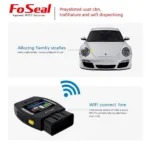An OBD2 code reader with live data and TPMS calibration capabilities is an essential tool for any car owner or mechanic. This guide will explore the benefits of these advanced scanners, key features to consider, and how they can help you diagnose and fix car problems efficiently.
Understanding OBD2, Live Data, and TPMS Calibration
Before diving into the details, let’s clarify what these terms mean:
- OBD2 (On-Board Diagnostics 2): A standardized system that allows external devices to access your car’s computer and retrieve diagnostic information.
- Live Data: Real-time information from your car’s sensors, providing insights into engine performance, transmission, emissions, and more.
- TPMS (Tire Pressure Monitoring System): A system that monitors tire pressure and alerts you to low pressure, ensuring optimal tire life and fuel efficiency. Calibration involves resetting the TPMS after changing tires or sensors.
Why Choose an OBD2 Code Reader with Live Data and TPMS Calibration?
A basic code reader might only show you the error code, leaving you to research its meaning and potential solutions. However, an advanced scanner with live data and TPMS calibration empowers you with:
- In-depth Diagnostics: Go beyond just reading codes. Analyze live data to pinpoint the root cause of issues, like a failing sensor or a vacuum leak.
- Informed Repair Decisions: Make data-driven decisions about repairs, avoiding unnecessary part replacements and saving money.
- Performance Monitoring: Track vital engine parameters like RPM, temperature, and oxygen sensor readings to ensure your car runs smoothly.
- Enhanced Safety: The TPMS calibration feature allows you to keep your tires at the optimal pressure, promoting safe driving and extending tire lifespan.
Essential Features to Look For
When choosing an OBD2 code reader with live data and TPMS calibration, consider these features:
- Wide Vehicle Compatibility: Ensure the scanner supports your car’s make, model, and year. Look for scanners that cover a wide range of OBD2 protocols.
- User-Friendly Interface: An intuitive interface with a clear display makes navigating menus and interpreting data easier.
- Live Data Graphing: Visualize data trends over time to identify intermittent problems and analyze performance.
- DTC Library: An integrated library that explains error codes in plain language, eliminating the need for external lookup.
- TPMS Relearn Procedures: The scanner should guide you through the process of calibrating your TPMS sensors.
- Data Logging and Sharing: The ability to record and export data for further analysis or sharing with a mechanic.
- Software Updates: Regular software updates ensure compatibility with new car models and add features.
Benefits for Car Owners and Mechanics
For Car Owners:
- Save Money on Repairs: Diagnose problems yourself and avoid unnecessary trips to the mechanic.
- Gain Peace of Mind: Confidently monitor your car’s health and address issues proactively.
- Improve Fuel Efficiency: Ensure your engine is running optimally and maintain proper tire pressure.
- Become More Car Savvy: Gain a deeper understanding of your vehicle’s systems and how they work.
For Mechanics:
- Enhance Diagnostic Efficiency: Quickly identify problems and confirm repairs with live data.
- Streamline TPMS Services: Perform TPMS calibration quickly and accurately, improving customer satisfaction.
- Access Advanced Features: Some scanners offer specialized functions like ABS bleeding, airbag reset, and more.
Choosing the Right OBD2 Scanner
The market offers a wide variety of OBD2 scanners. Research and compare different models based on your needs and budget. Consider factors like:
- Wired vs. Wireless: Wireless scanners offer greater convenience and flexibility.
- Brand Reputation: Choose reputable brands known for quality and reliability.
- Customer Reviews: Read online reviews to understand real-world user experiences.
For a reliable and feature-rich option, consider the Tunemaster OBD2 scanner, known for its wide vehicle coverage, user-friendly interface, and advanced functionalities. If you’re looking for a budget-friendly yet capable choice, the Launch OBD2 CRP129E is an excellent option.
Conclusion
An OBD2 code reader with live data and TPMS calibration is a valuable investment for any car enthusiast or professional. It empowers you with the knowledge and tools to maintain your car’s health, diagnose problems accurately, and make informed repair decisions. When choosing a scanner, consider your specific needs, budget, and the features discussed in this guide.


